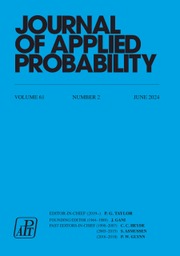No CrossRef data available.
Article contents
Mixed-state branching evolution for cell division models
Published online by Cambridge University Press: 29 September 2025
Abstract
We prove a scaling limit theorem for two-type Galton–Watson branching processes with interaction. The limit theorem gives rise to a class of mixed-state branching processes with interaction used to simulate evolution for cell division affected by parasites. Such processes can also be obtained by the pathwise-unique solution to a stochastic equation system. Moreover, we present sufficient conditions for extinction with probability 1 and the exponential ergodicity in the  $L^1$-Wasserstein distance of such processes in some cases.
$L^1$-Wasserstein distance of such processes in some cases.
MSC classification
Information
- Type
- Original Article
- Information
- Copyright
- © The Author(s), 2025. Published by Cambridge University Press on behalf of Applied Probability Trust
References
Aldous, D. (1978). Stopping times and tightness. Ann. Prob. 6, 335–340.10.1214/aop/1176995579CrossRefGoogle Scholar
Athreya, K. B. and Ney, P. E. (1972). Branching Processes. Springer, New York.10.1007/978-3-642-65371-1CrossRefGoogle Scholar
Bansaye, V. and Tran, V. C. (2011). Branching Feller diffusion for cell division with parasite infection. ALEA, Lat. Am. J. Prob. Math. Statist. 8, 95–127.Google Scholar
Berestycki, J., Kyprianou, A. E. and Murillo-Salas, A. (2011). The prolific backbone for supercritical superprocesses. Stoch. Process. Appl. 121, 1315–1331.10.1016/j.spa.2011.02.004CrossRefGoogle Scholar
Bertoin, J., Fontbona, J. and Martinez, S. (2008). On prolific individuals in a supercritical continuous-state branching process. J. Appl. Prob. 45, 714–726.10.1239/jap/1222441825CrossRefGoogle Scholar
Chen, S. and Li, Z. (2021). Continuous-time mixed-state branching processes and stochastic equations. Acta Math. Sci. 41, 1445–1473.10.1007/s10473-021-0504-7CrossRefGoogle Scholar
Cranston, M. and Greven, A. (1995). Coupling and harmonic functions in the case of continuous-time Markov processes. Stoch. Process. Appl. 60, 261–286.10.1016/0304-4149(95)00055-0CrossRefGoogle Scholar
Dawson, D. A. and Li, Z. (2006). Skew convolution semigroups and affine Markov processes. Ann. Prob. 34, 1103–1142.10.1214/009117905000000747CrossRefGoogle Scholar
Dawson, D. A. and Li, Z. (2012). Stochastic equations, flows and measure-valued processes. Ann. Prob. 40, 813–857.10.1214/10-AOP629CrossRefGoogle Scholar
Duquesne, T. and Winkel, M. (2007). Growth of Lévy trees. Prob. Theory Relat. Fields 139, 313–371.10.1007/s00440-007-0064-3CrossRefGoogle Scholar
Ethier, S. N. and Kurtz, T. G. (1986). Markov Processes: Characterization and Convergence
. John Wiley, New York.10.1002/9780470316658CrossRefGoogle Scholar
Feketa, D., Fontbona, J. and Kyprianou, A. E. (2019). Skeletal stochastic differential equations for continuous-state branching processes. J. Appl. Prob. 56, 1122–1150.10.1017/jpr.2019.67CrossRefGoogle Scholar
Friesen, M., Jin, P., Kremer, J. and Rüdiger, B. (2023). Exponential ergodicity for stochastic equations of nonnegative processes with jumps. ALEA, Lat. Am. J. Prob. Math. Statist. 20, 593–627.10.30757/ALEA.v20-22CrossRefGoogle Scholar
Fu, Z. and Li, Z. (2010). Stochastic equations of non-negative processes with jumps. Stoch. Process. Appl. 120, 306–330.10.1016/j.spa.2009.11.005CrossRefGoogle Scholar
Ikeda, N. and Watanabe, S. (1981). Stochastic Differential Equations and Diffusion Processes, 2nd edn. North-Holland, Amsterdam.Google Scholar
Ji, L. and Xiong, J. (2022). Superprocesses for the population of rabbits on grassland. Proc. Steklov Inst. Math. 316, 195–208.10.1134/S008154382201014XCrossRefGoogle Scholar
Kawazu, K. and Watanabe, S. (1971). Branching processes with immigration and related limit theorems. Theory Prob. Appl. 16, 36–54.10.1137/1116003CrossRefGoogle Scholar
Kyprianou, A. E. (2014). Fluctuations of Lévy Processes with Applications, 2nd edn. Springer, Heidelberg.10.1007/978-3-642-37632-0CrossRefGoogle Scholar
Li, P., Li, Z., Wang, J. and Zhou, X. (2025). Exponential ergodicity of branching processes with immigration and competition. Ann. Inst. H. Poincaré Prob. Statist. 61, 350–384.10.1214/23-AIHP1425CrossRefGoogle Scholar
Li, P. and Wang, J. (2020). Exponential ergodicity for general continuous-state nonlinear branching processes. Electron. J. Prob. 25, 125.10.1214/20-EJP528CrossRefGoogle Scholar
Li, P., Yang, X. and Zhou, X. (2019). A general continuous-state nonlinear branching process. Ann. Appl. Prob. 29, 2523–2555.10.1214/18-AAP1459CrossRefGoogle Scholar
Li, Z. (2006). A limit theorem for discrete Galton–Watson branching processes with immigration. J. Appl. Prob. 43, 289–295.10.1239/jap/1143936261CrossRefGoogle Scholar
Li, Z. (2011). Measure-Valued Branching Markov Processes. Springer, New York.10.1007/978-3-642-15004-3CrossRefGoogle Scholar
Li, Z. (2020). Continuous-state branching processes with immigration. In From Probability to Finance: Mathematical Lectures from Peking University, ed. Y. Jiao. Springer, Singapore.Google Scholar
Li, Z. and Ma, C. (2015). Asymptotic properties of estimators in a Cox–Ingersoll–Ross model. Stoch. Process. Appl. 125, 3196–3233.10.1016/j.spa.2015.03.002CrossRefGoogle Scholar
Liu, J. (2024). Scaling limits of controlled branching processes. Statist. Prob. Lett. 208, 110081.10.1016/j.spl.2024.110081CrossRefGoogle Scholar
Luo, D. and Wang, J. (2019). Refined basic couplings and Wasserstein-type distances for SDEs with Lévy noises. Stoch. Process. Appl. 129, 3129–3173.10.1016/j.spa.2018.09.003CrossRefGoogle Scholar
Ma, C. (2009). A limit theorem of two-type Galton–Watson branching processes with immigration. Statist. Prob. Lett. 79, 1710–1716.10.1016/j.spl.2009.04.008CrossRefGoogle Scholar
Marguet, A. and Smadi, C. (2024). Spread of parasites affecting death and division rates in a cell population. Stoch. Process. Appl. 168, 104262.10.1016/j.spa.2023.104262CrossRefGoogle Scholar
Osorio, L. and Winter, A. (2020). Two-level branching model for virus population under cell division. Preprint, arXiv:2004.14352.Google Scholar
Villani, C. (2009). Optimal Transport, Old and New. Springer, Berlin.
10.1007/978-3-540-71050-9CrossRefGoogle Scholar


